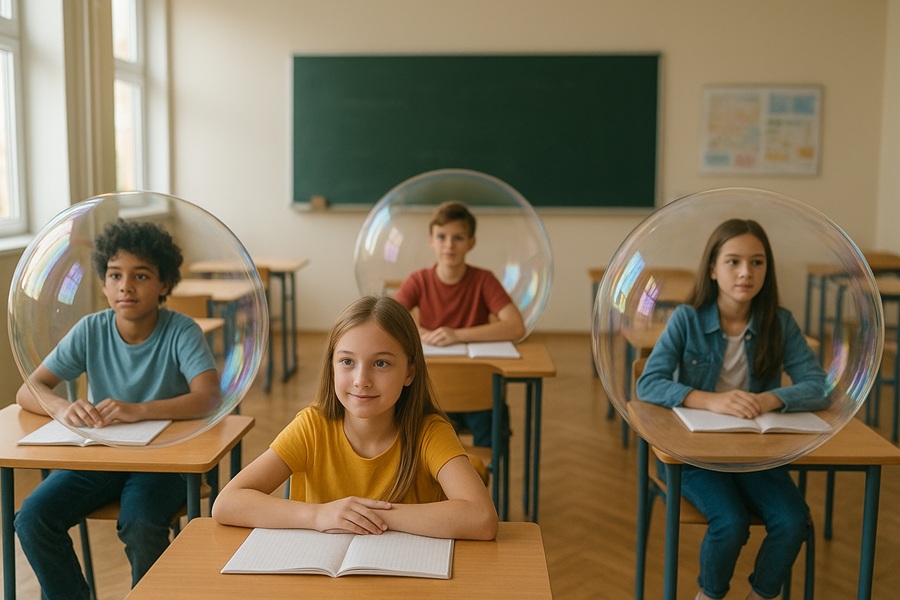- Cover
- 18 de November de 2025
- No Comment
- 7 minutes read
Personalise, classify, sell

Multiplying labels at school may create an illusion of inclusion, but in fact it fosters isolation.
THE GREAT SCAM. Opinion Section by David Cerdá

Now a new trend is making its way into schools: the Highly Sensitive Person (HSP) — an attractive bit of repackaging for parents and schools eager for labels that make their bearers feel special. But far from strengthening children, it locks them into fragility and undermines the integrative purpose of education.
You’ve probably heard of a Highly Sensitive Child or adult. The term was coined in the 1990s by the American psychologist Elaine Aron, who chose to baptise — with something very close to a self-help label — those who, essentially, feel things more intensely than most. She presented it as a legitimate personality trait, though to many of us it sounds more like an elegant justification for ordinary melodrama. The idea has since travelled far. Once the fashion for “my child has ADHD” had run its course — we long ago crossed the threshold of overdiagnosis — and with “my child is gifted” already firmly established, another wave arrived: “I’m an HSP, and my child inherited it”. A ready source of consolation — or excuse — for a whole repertoire of temperamental quirks. Nobody denies that some people are more sensitive than others, or that human reactions vary widely. What is questionable is how the term, once elevated to the status of a “condition”, has become suspiciously elastic: equally useful for selling books and for blurring the boundaries of serious diagnosis. It belongs far more to the realm of emotional marketing than to that of solid science.
The controversy surrounding Elaine Aron and the Highly Sensitive Person (HSP) centres above all on the scientific foundations of the concept. In her 1996 book The Highly Sensitive Person, Aron describes high sensitivity as an inherited temperamental trait affecting 15–20% of the population. The trouble is that much of her research relies on self-report questionnaires designed by Aron herself (the Highly Sensitive Person Scale), whose validation is disputed and whose interpretative scope is remarkably wide. Many psychologists argue that what she calls “high sensitivity” is in fact a collage of neuroticism, social anxiety and high empathy — all well-established traits within personality psychology. And although a handful of neuroimaging studies point to differences in brain activation among “these personalities” (rarely have quotation marks been more justified), the evidence remains limited, fragmentary and difficult to replicate. It looks less like a groundbreaking discovery than a brilliant piece of emotional rebranding — a hit in the wellness market, no doubt, but resting on very shaky scientific ground.
Not that any of this bothers those keen to sell us things we don’t need. The ubiquitous Álvaro Bilbao — who has a finger in every pie — speaks casually now of Highly Sensitive Children. Various organisations circling the educational marketplace use the idea to sell consultations while demanding adaptations in schools (imagine that, in schools that often cannot even afford air conditioning). And of course, there is already a national association, PAS España, which, besides pathologising the matter “Por qué ser NAS se confunde con otros trastornos” (“because being Highly Sensitive Children is confused with other disorders”), treats us to a collection of banalities and suggests that such children are “more intuitive, reflective and creative”, and that “some may grow up to be excellent athletes or great musicians” — which, needless to say, could be said of absolutely anyone.
The fascination with HSPs in schools fits all too neatly with that deeply human — and deeply dangerous — impulse to believe that one is special, and still more, that one’s child is. Labelling a pupil as “highly sensitive” satisfies a parental vanity that turns every tear into a sign of latent genius. In practice, the illusion does not build resilience: it places the child on a fragile pedestal where the slightest frustration is interpreted as an injustice to their condition rather than an opportunity to grow. Formal education, while acknowledging individual differences, cannot capitulate to the cult of uniqueness. Its task is to guide children into the shared experience of being “one among others”, for it is only through the friction of equality that we learn to live together. The exclusive display case of the “special child” distances us from deeper, collective educational aims — and, needless to say, does nothing to diminish any future opportunity for creative, sensitive or artistic talents to flourish. What it provides is a common ground of civility — a foundation of non-exceptionality — from which eventual exceptionalities can be lived and expressed in full.
We must make room for individuality in the classroom. But we do not need ever more subcategories that label children and further fragment a society that is already less a community and increasingly a mosaic of market-designed tribes. As Zygmunt Bauman warned in Liquid Modernity, “the more society disintegrates into individual fragments, the more vulnerable it becomes to the forces that manipulate it”. That is precisely what we are encouraging. Multiplying labels in schools may create the appearance of inclusion but, in reality, it fosters isolation — and invites each child to see themselves as a tribe of one. Education should be the opposite: a space in which we learn that differences enrich us, yes — but that healthy human connectedness and a courageous, critical polis are essential if the good life is to flourish.
Source: educational EVIDENCE
Rights: Creative Commons

